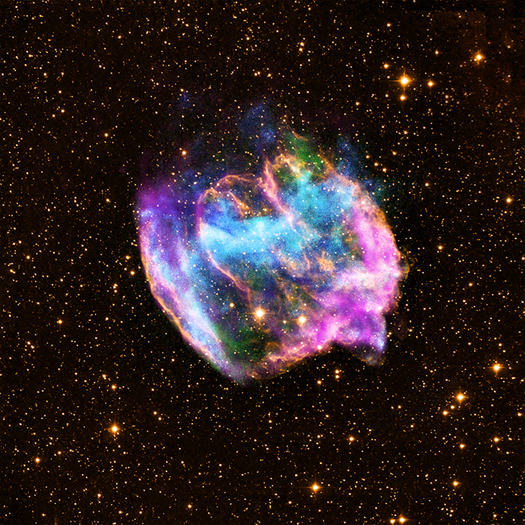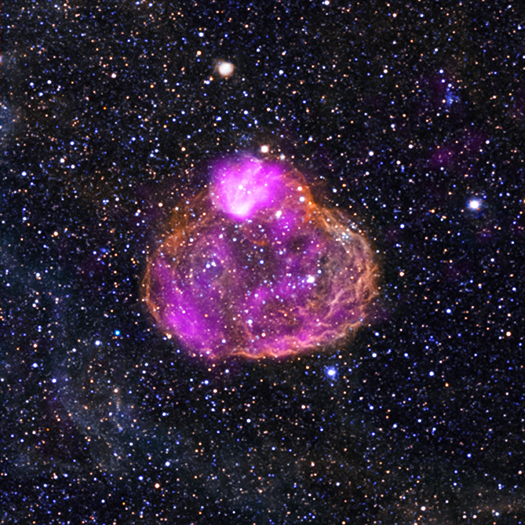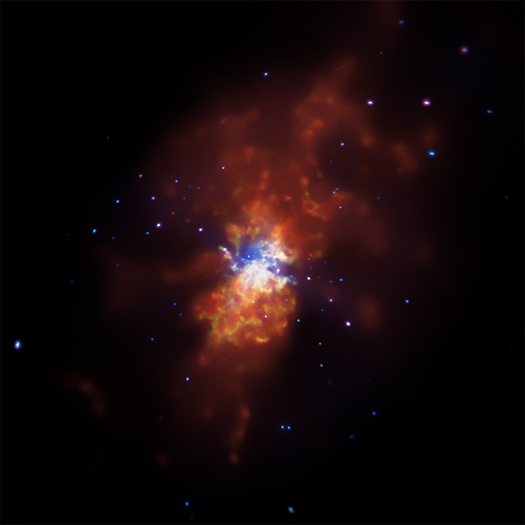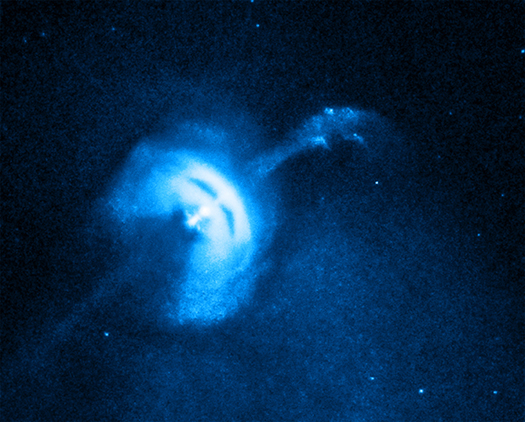Rare Explosion May Have Created Our Galaxy's Youngest Black Hole
The highly distorted supernova remnant shown in this image may contain the most recent black hole formed in the Milky Way galaxy. The image combines X-rays from NASA's Chandra X-ray Observatory in blue and green, radio data from the NSF's Very Large Array in pink, and infrared data from Caltech's Palomar Observatory in yellow.
Exotic Supernovas in our own Galactic Backyard

We are delighted to welcome Laura Lopez as a guest blogger today. Laura is first author of a paper describing the rare explosion that may have created the youngest known black hole in our Galaxy. Laura Lopez is currently a NASA Einstein Fellow and Pappalardo Fellow in Physics at MIT. Laura received her PhD in astronomy & astrophysics from the University of California Santa Cruz in 2011. Before her time at UCSC, she earned her bachelors degree in physics from MIT in 2004. Laura is originally from Barrington, IL, a northwest suburb of Chicago. Her research focuses on probing the beginning and ending of the stellar life cycle: how stars are born and how stars end their lives through supernova explosions.
A few years ago when I was a bright-eyed PhD student, I stumbled upon a press release making a provocative argument: a thousand year old supernova remnant in our Galaxy called W49B may have formed from a gamma-ray burst. Gamma-ray bursts (GRBs) are extreme supernova explosions thought to mark the end of the lives of some very massive stars, and they are the most energetic and luminous events in the Universe. Although astronomers have now found several hundred gamma-ray bursts, these explosions tend to be billions of light years away. So the claim that one may have occurred in our own Galaxy seemed astounding. It got me thinking: what would a gamma-ray burst look like after a thousand years, and what would it leave behind?
Women In The High-Energy Universe: Megan Watzke
Megan Watzke is the press officer for NASA's Chandra X-ray Observatory. Her responsibilities include writing press releases, organizing press conferences, and more for newsworthy results from the telescope. She is also a co-investigator in the "From Earth to the Universe," "From Earth to the Solar System," and "Here, There and Everywhere" projects.
Like many people who work in science, I had an interest in the subject since I was a little kid. I remember going to the public library at 7 or 8 years old and asking the librarian for books on pulsars and quasars (they sounded like the coolest things I had ever heard of.)
Stellar Effervescence on Display
This composite image shows the superbubble DEM L50 (a.k.a. N186) located in the Large Magellanic Cloud about 160,000 light years from Earth. Superbubbles are found in regions where massive stars have formed in the last few million years. The massive stars produce intense radiation, expel matter at high speeds, and race through their evolution to explode as supernovas . The winds and supernova shock waves carve out huge cavities called superbubbles in the surrounding gas.
"All the Data that FITS"
This week marks a milestone in the openFITS collection as we've nearly doubled the amount of data offered up for curious minds to explore and create their own images. We now offer a collection of 17 data sets covering supernova remnants, galaxies, neutron stars, pulsars, and the supermassive black hole at the center of our very own galaxy, the Milky Way. Additionally, we've updated the openFITS overview and tutorials to reflect changes in the newest version of GIMP (v2.8), our choice of image processing platform for this project. GIMP v2.8 is now available as a native application on Mac OS X and offers some exciting new features as well as laying the groundwork for very exciting developments to come.
Astro-ganza in Long Beach
This week, the American Astronomical Society (AAS) is holding its 221st meeting in Long Beach, CA. These meetings are a chance for astronomers to get together and share some of their latest findings. Some of these are even featured in press releases and press conferences including the newest results from Chandra. You'll find scientists from government agencies like NASA and researchers from universities. You see aspiring graduate students mixing with award-winning astronomers and everyone in between.
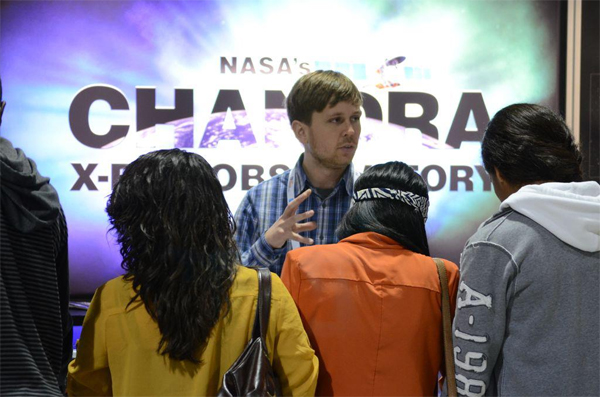
A Cosmic Corkscrew
It's a pleasure to welcome Martin Durant, of the University of Toronto, for a guest blog article giving more background about his work on the striking variations discovered in the Vela Pulsar.
Pulsars, the remnants of exploded massive stars, are fascinating objects. They have more mass than the sun, squeezed into a ball the size of a city, making them denser than the nucleus of an atom. Add to this mixture immense magnetic fields and rapid rotation, and you have the perfect mix of high energy particles and fundamental forces – nuclear, electromagnetic and gravitational – to put the extreme limits of physical models to the test. Each pulsar, when studied in sufficient detail, appears to be unique. To understand the differences between these exotic objects, we must use all available information and collect data across the spectrum, from radio to gamma rays.
New Chandra Movie Features Neutron Star Action
This movie from NASA's Chandra X-ray Observatory shows a fast moving jet of particles produced by a rapidly rotating neutron star , and may provide new insight into the nature of some of the densest matter in the universe.
Never give up and trust your intuition
We are very pleased to welcome a guest blogger, Julie Hlavacek-Larrondo, who led the work described in our latest press release. Julie was raised in Montreal, Canada, and in 2007 completed a Bachelor’s degree in physics at the University of Montreal. Julie then obtained a Master’s degree in astrophysics. In 2012, she completed a PhD at the University of Cambridge. She is currently an Einstein Fellow at Stanford University.
It was during my Master degree at the University of Montreal that I realized just how fascinating black holes are.
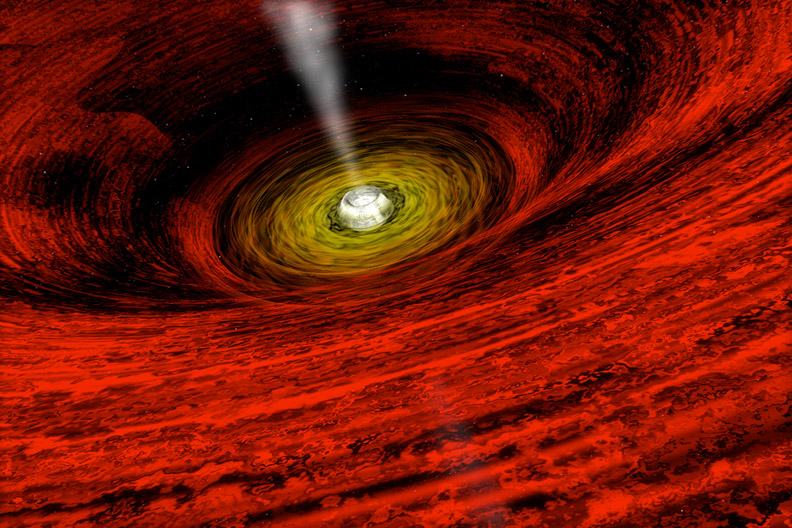
I remember stumbling upon a press release from Chandra in 2007. The Chandra space telescope revealed an image of a jet, powered by a supermassive black hole, blasting through its neighboring galaxy. What's so fascinating? Supermassive black holes are tiny objects, about a billion times smaller than the galaxy it resides in, yet, it can create jets that extend well beyond the size of the galaxy! How can something so small be so powerful?
From Super to Ultra: Just How Big Can Black Holes Get?
The black hole at the center of this galaxy is part of a survey of 18 of the biggest black holes in the universe. This large elliptical galaxy is in the center of the galaxy cluster PKS 0745-19, which is located about 1.3 billion light years from Earth. X-ray data from NASA's Chandra X-ray Observatory are shown in purple and optical data from the Hubble Space Telescope are in yellow.

